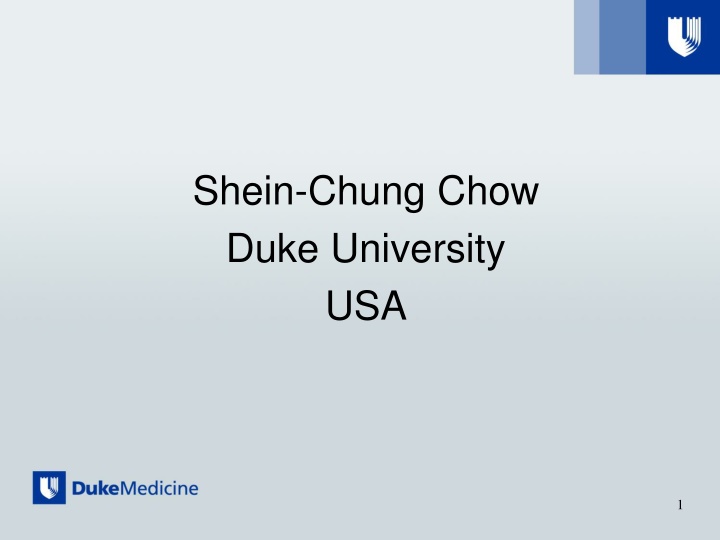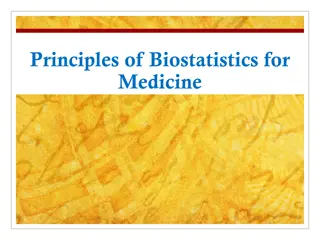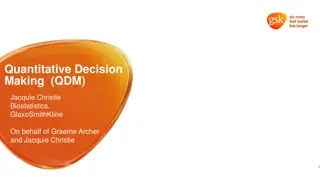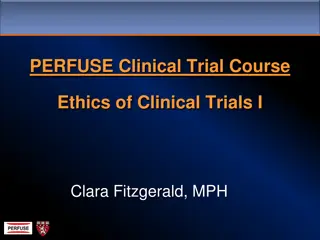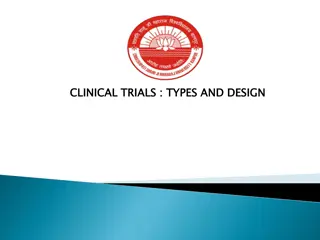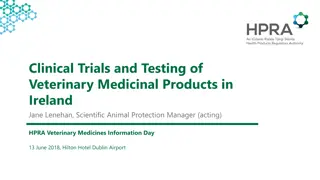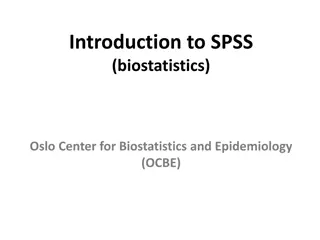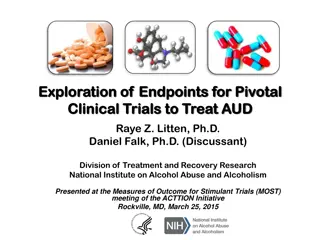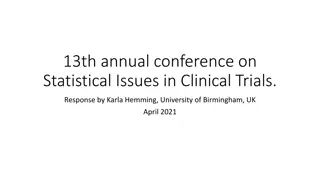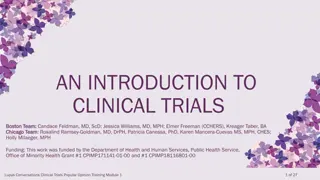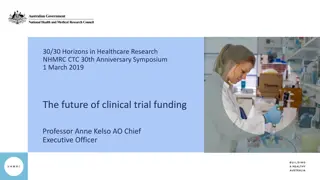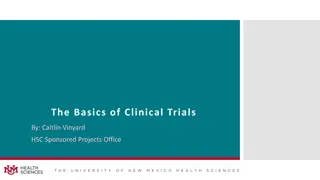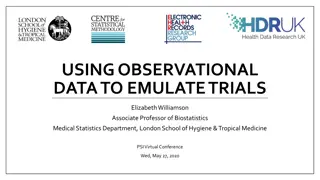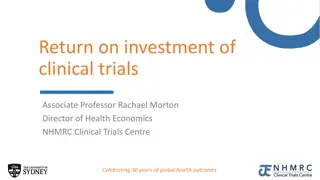Dr. Shein-Chung Chow - Biostatistics and Clinical Trials Expert
Dr. Shein-Chung Chow, a distinguished Professor of Biostatistics and Bioinformatics at Duke University, is a renowned expert in biostatistics, bioinformatics, and adaptive design methods in clinical trials. With an impressive publication record and a wealth of experience in academia and the pharmaceutical industry, Dr. Chow's research contributions have significantly impacted the field of clinical research and statistical methodology.
Download Presentation

Please find below an Image/Link to download the presentation.
The content on the website is provided AS IS for your information and personal use only. It may not be sold, licensed, or shared on other websites without obtaining consent from the author.If you encounter any issues during the download, it is possible that the publisher has removed the file from their server.
You are allowed to download the files provided on this website for personal or commercial use, subject to the condition that they are used lawfully. All files are the property of their respective owners.
The content on the website is provided AS IS for your information and personal use only. It may not be sold, licensed, or shared on other websites without obtaining consent from the author.
E N D
Presentation Transcript
Shein-Chung Chow Duke University USA 1
Dr. Shein-Chung Chow Biography Shein-Chung Chow, PhD. is a Professor of Biostatistics and Bioinformatics, Duke University School of Medicine, Durham, North Carolina. Prior to joining Duke University, he was Executive Director of National Clinical Trial Network Coordination Center of Taiwan. Prior to that, Dr. Chow held various management positions in the pharmaceutical industry. Dr. Chow is the Editor- in-Chief of the Journal of Biopharmaceutical Statistics and the Editor-in-Chief of the Biostatistics Book Series at Chapman and Hall/CRC Press of Taylor & Francis Group. He was elected Fellow of the American Statistical Association in 1995. He was the recipient of the DIA Outstanding Service Award (1996), and ICSA Extraordinary Achievement Award (1996). Dr. Chow is the author or co- author of over 200 methodology papers and 20 books, which include Design and Analysis of Bioavailability and Bioequivalence Studies, Design and Analysis of Clinical Trials, Sample Size Calculations in Clinical Research, and Adaptive Design Methods in Clinical Trials 2
Dr. Shein-Chung Chow Research Interest Biostatistics Bioinformatics Adaptive Design Methods in Clinical Trials 3
Recent Publication of Dr. Shein-Chung Chow 2012~2014 Books: Liu, J.P., Chow, S.C., and Hsiao, C.F. (Ed) (2012). Design and Analysis of Bridging Studies. Taylor & Francis, New York, New York. Chow, S.C. and Liu, J.P. (2013). Design and Analysis of Clinical Trials Revised and Expanded, Third Edition, John Wiley & Sons, New York, New York. In press. Chow, S.C. (2013). Biosimilars: Design and Analysis of Follow-on Biologics. Chapman and Hall/CRC Press, Taylor & Francis, New York. Chow, S.C. (2015). Statistical Methods for Traditional Chinese Medicine. Publishing agreement awarded. Scheduled to be published in August, 2015. Research Papers: Chow, S.C., Chiang C., Liu, J.P., and Hsiao, C.F. (2012). Statistical methods for bridging studies. Journal of Biopharmaceutical Statistics, 22, 903-915. Jung, S.H. and Chow, S.C. (2012). On sample size calculation for comparing survival curves under general hypotheses testing. Journal of Biopharmaceutical Statistics, 22, 485-495. Chow, S.C. and Pong, A. (2012). Issues in global pharmaceutical development. To appear. Tsou, H.H., Chow, S.C., Chang, W.J., Ko, F.S., Chen, Y.M., and Hsiao, C.F. (2012). Considering regional differences in the design and evaluation of multi-regional clinical trials. To appear. Chow, S.C. (2012). Scientific issues for assessing biosimilars in the United States. Journal of Biometrics and Biostatistics, 3:e107, doi10.4172/2155-6180.1000e107. Chow, S.C., Corey, R., and Lin, M. (2012). On independence of data monitoring committee in adaptive clinical trial. Journal of Biopharmaceutical Statistics, 22, 853-867. Lu, Q.S., Tse, S.K., Chow, S.C., and Lin, M (2012). Analysis of time-to-event data with non-uniform patient entry and loss to follow-up under a two-stage seamless adaptive design with Weibull distribution. Journal of Biopharmaceutical Statistics, 22, 773-784. Wang, J. and Chow, S.C. (2012). On regulatory approval pathway of biosimilar products. Pharmaceuticals, 5, 353-368; doi:10.3390/ph5040353. Chow, S.C. (2012). Flexible, adaptive or attractive clinical trial design. Drug Designing, 1:e104, doi:10.4172/ddo.1000e104. 4
Recent Publication of Dr. Shein-Chung Chow 2012~2014 Research Papers: Lin, A. and Chow, S.C. (2013).Data monitoring committees in adaptive clinical trials. Clinical Investigation, Vo. 3, No. 7, 605-607. Chow, S.C. and Ju, C. (2013). Assessing biosimilarity and interchangeability of biosimilar products under the Biologics Price Competition and Innovation Act. Generics and Biosimilars Initiative Journal, 2, 20-25. Chow, S.C., Wang, J., Endrenyi, L., and Lachenbruch, P. (2013). Scientific considerations for assessing biosimilar products. Statistics in Medicine, 32, 370-381 Chow, S.C., Endrenyi, L., and Lachenbruch, P.A. (2013). Comments on FDA draft guidances on biosimilar products. Statistics in Medicine, 32, 364-369. Endrenyi, L., Chang C., Chow, S.C., and Tothfalusi, L. (2013). On the interchangeability of biologic drug products. Statistics in Medicine, 32, 434-441. Hsieh, T.C., Chow, S.C., Yang, L.Y., and Chi, E. (2013). The evaluation of biosimilarity index based on reproducibility probability for assessing follow-on biologics. Statistics in Medicine, 32, 406-414. Chow, S.C., Yang, L.Y., Starr, A., and Chiu, S.T. (2013). Statistical methods for assessing interchangeability of biosimilars. Statistics in Medicine, 32, 442-448. Yang, J., Zhang, N., Chow, S.C., and Chi, E. (2013). An adaptive F-test for heterogeneity of variability in follow-on biologic products. Statistics in Medicine, 415-423. Zhang, H., Chow, S.C., and Chi, E. (2013). Comparison of different biosimilarity criteria under various designs. Journal of Biopharmaceutical Statistics, To appear. Chow, S.C. (2013). Assessing biosimilarity and interchangeability of biosimilar products. Statistics in Medicine, 32, 361-363. Kang, S.H. and Chow, S.C. (2013). Statistical assessment of biosimilarity based on relative distance between follow-on biologics. Statistics in Medicine, 32, 382-392. Lin M., Yang R., and Chow S. C. (2013). A joint model for identifying haplotypes that control drug response and time-to-event. Statistics in Medicine, currently under revision. Zhang, N., Yang, J., Chow, S.C. and Chi, E. (2013). Impact of variability on the choice of biosimilarity limits in assessing follow-on biologics. Statistics in Medicine, 32, 424-433. 5
Recent Publication of Dr. Shein-Chung Chow 2012~2014 Research Papers: Lin, J.R., Chow, S.C., Chang, C.H., Lin, Y.C., and Liu, J.P. (2013). Application of the parallel line assay to assessment of biosimilar products based on binary endpoints, Statistics in Medicine, 32, 449-461. Chow, S.C. and Chiu, S.T. (2013). Sample Size and Data Monitoring for Clinical Trials with Extremely Low Incidence Rate. Therapeutic Innovation & Regulatory Science, 47, 438-446. Chow, S.C. and Chiu, S.T. (2013). On design and analysis of clinical trials. Journal of Drug Designing, 2:1http://dx.doi.org/10.4172/2169- 0138.1000102 Lu, Y., Chow, S.C. and Zhang, Z.Z. (2013). Statistical designs for assessing interchangeability of biosimilar products. Drug Designing, 2, No.3, 109-114. Zhang, A., Tzeng, J.Y., and Chow, S.C. (2013). Establishment of reference standards in biosimilars. Generic and Biosimilar Initiatives, 2, 173- 177. Zhang, A., Tzeng, J.Y., and Chow, S.C. (2013).Statistical considerations in biosimilar assessment using biosimilarity index. Journal of Bioavailability & Bioequivalence, 5, 209-214. Chow, S.C. (2014). Adaptive clinical trial design. Annual Review of Medicine. 65, 405-415. Chow, S.C. (2014). Bioavailability and bioequivalence in drug development. WIRES Computational Statistics. 6 (4), 304-312. Tothfalusi L., Endrenyi L., and Chow, S.C. (2014). Statistical and regulatory considerations in assessments of interchangeability. European Journal of Health Economics, 15 (Suppl 1):S5 S11 DOI 10.1007/s10198-014-0589-1. Wu, Y.J., Tan, T.S., Chow, S.C., and Hsiao, C.F. (2014). Sample size estimation of multiregional clinical trials with heterogeneous variability across regions. Journal of Biopharmaceutical Statistics, 24, 254-271. Zhang, A., Tzeng, J.Y., and Chow, S.C. (2014). The assessment of biosimilarity with SABE and IBE criteria under a switching/alternating design. Journal of Generics and Biosimilar Initiatives, 2, In press. Lu, Y., Chow, S.C., and Zhu, S.C. (2014). In vitro and in vivo bioequivalence testing. Journal of Bioavailability and Bioequivalence, 6, 67-74. Chiu, S.T., Chen C., Chow, S.C., and Chi, M. (2014). Assessing biosimilarity of biosimilar products using GPQ. Journal of Generics and Biosimilars Initiatives, 2, No. 3, 130-135. 6
Adaptive Design Methods in Clinical Research Shein-Chung Chow, PhD Department of Biostatistics and Bioinformatics Duke University School of Medicine Durham, North Carolina sheinchung.chow@duke.edu 2424 Erwin Road, Suite 1102, Room 11068 Durham, NC 27710, USA Tel: 1-919-668-7523 Fax: 1-919-668-5888
Outline Background and motivation What is adaptive design? Type of adaptive designs Regulatory perspectives Statistical perspectives Possible benefits Remarks
Background Increasing spending of biomedical research does not reflect an increase of the success rate of pharmaceutical development. Many drug products were withdrawn or recalled due to safety issues after regulatory approval.
The causes Woodcock (2004) A diminished margin for improvement that escalates the level of difficulty in proving drug benefits. Genomics and other new science have not yet reached their full potential. Mergers and other business arrangements have decreased candidates. Easy targets are the focus as chronic diseases are harder to study. Failure rates have not improved. Rapidly escalating costs and complexity decrease willingness/ability to bring many candidates forward into the clinic.
Critical Path Initiative In its 2004 Critical Path Report, the FDA presented its diagnosis of the scientific challenges underlying the medical product pipeline problems. On March 16, 2006, the FDA released a Critical Path Opportunities List that outlines 76 initial projects (six broad topic areas) to bridge the gap between the quick pace of new biomedical discoveries and the slower pace at which those discoveries are currently developed into therapies.
Critical path opportunities list 1. Better evaluation tools 2. Streamlining clinical Trials Advancing innovative trial designs 3. Harnessing bioinformatics 4. Moving manufacturing into the 21st century 5. Developing products to address urgent public health needs 6. Specific at-risk populations - pediatrics
Advancing innovative trial designs Design of active controlled trials Enrichment designs Use of prior experience or accumulated information in trial design Development of best practices for handling missing data Development of trial protocols for specific therapeutic areas Analysis of multiple endpoints
Use of prior experience or accumulated information in trial design The use of Bayesian approach in clinical trial design CDRH has published a guidance on Bayesian approach in devices The use of adaptive design methods in clinical trials The use of Bayesian adaptive design in clinical trials 14
Motivation The use of adaptive design is to give the investigator(s) the flexibility for identifying any signal, possible trend/pattern, and ideally optimal benefit regarding safety/efficacy of the test treatment under investigation The use of adaptive design is to speed up the development process in a more efficient way without undermining the scientificvalidity of the development 15
An example the development of Velcade Indication Multiple myeloma (accelerated track for orphan drug) Approved by the FDA on June 23, 2008 Flexibility Modified clinical trial design during the conduct of the trials such as change primary study endpoint , change hypotheses, and two-stage adaptive design Efficiency (speed up development process) It only took 2 years and 4 months (from first patient in to the last patient out) to receive approvable letter from FDA based on a phase II study. 16
What do we learn from this example? If the drug is promising and/or no alternative treatments are available, FDA is willing to help the sponsor to identify clinical benefits of the drug under investigation. New methodology is acceptable to the FDA as long as the sponsor can demonstrate the following Statistical/scientific validity and integrity of the proposed method Integrity of the data collected from the trial 17
What is adaptive design? There is no universal definition. Adaptive randomization, group sequential, and sample size re-estimation, etc. Chow, Chang, and Pong (2005) US PhRMA (2006) US FDA (2010) Adaptive design is also known as Flexible design (EMEA, 2002, 2006) Attractive design (Uchida, 2006)
Chow, Chang, and Pongs definition Chow SC, Chang M, Pong A (2005). J. Biopharm. Stat., 15 (4), 575-591. An adaptive design is a design that allows modification (adaptation) to some aspects (e.g., trial and/or statistical procedures) of on-going trials after initiation without undermining the validity and integrity of the trials.
Trial procedures Eligibility criteria Study dose/regimen and duration Study endpoints Laboratory testing procedures Diagnostic procedures Criteria for evaluability and/or assessment of clinical responses Deletion/addition of treatment groups etc.
Statistical procedures Randomization procedures in treatment allocation Study objectives/hypotheses Study design Sample size re-assessment/adjustment Data monitoring and/or interim analysis Statistical analysis plan Methods for data analysis etc.
Chow-Chang-Pongs definition Characteristics Adaptation is not limited to a design feature Changes can be made prospectively, concurrently, and/or retrospectively. Comments It reflects real clinical practice (e.g., concurrent protocol amendments and/or SAP). It is flexible and attractive.
PhRMAs definition PhRMA (2006), J. Biopharm. Stat., 16 (3), 275-283. An adaptive design is referred to as a clinical trial design that uses accumulating data to decide on how to modify aspects of the study as it continues, without undermining the validity and integrity of the trial.
PhRMAs definition Characteristics Adaptation is a design feature. Changes are made by design not on an ad hoc basis. Comments It does not reflect real practice Ad hoc protocol amendments It may not be flexible as it means to be Adaption is by design only
FDAs definition FDA Guidance for Industry Adaptive Design Clinical Trials for Drugs and Biologics Feb, 2010 An adaptive design clinical study is defined as a study that includes a prospectively planned opportunity for modification of one or more specified aspects of the study design and hypotheses based on analysis of data (usually interim data) from subjects in the study
FDAs definition Characteristics Adaptation is a prospectively planned opportunity. Changes are made based on analysis of data (usually interim data). Comments It is not flexible because only prospective adaptations are allowed It does not reflect real practice (e.g., protocol amendments) It does not mention validity and integrity?
FDAs definition Comments The interpretations vary from statistical reviewer (and/or medical reviewer) to statistical reviewer (and/or medical reviewer) FDA encourages the sponsors consulting with statistical/medical reviewers when utilizing adaptive design in the intended clinical trials It classifies adaptive designs into well-understooddesigns and less well-understooddesigns It is general guidance not a design-specific guidance.
FDAs definition Well-understood design Has been in practice for years Statistical methods are well established FDA is familiar with the study design Less well-understood design Relative merits and limitations have not yet been fully evaluated Valid statistical methods have not yet been developed/established FDA does not have sufficient experience for submissions utilizing such study design
Adaptation An adaptation is defined as a change or modification made to a clinical trial before and during the conduct of the study. Examples include Relax inclusion/exclusion criteria Change study endpoints Modify dose and treatment duration etc.
Types of adaptations Prospective adaptations Adaptive randomization Interim analysis Stopping trial early due to safety, futility, or efficacy Sample size re-estimation, etc. Concurrent adaptations Trial procedures Retrospective adaptations Statistical procedures
Implementation of adaptations Prospective adaptations Design features Implemented by study protocol Concurrent adaptations Changes made during the conduct of the study Implemented by protocol amendments Retrospective adaptations Changes made after the conduct of the study Implemented by statistical analysis plan prior to database lock and/or data unblinding
Ten adaptive designs Adaptive randomization design Group sequential design Flexible sample size re-estimation design Drop-the-losers (pick-the-winner) design Adaptive dose-finding design Biomarker-adaptive design Adaptive treatment-switching design Adaptive-hypotheses design Adaptive seamless design Two-stage phase I/II (or II/III) adaptive design Multiple adaptive design (any combinations of the above designs)
Most popular adaptive designs Adaptive randomization design Group sequential design Flexible sample size re-estimation design Drop-the-losers (pick-the-winner) design Adaptive dose finding design Biomarker-adaptive design Adaptive treatment-switching design Adaptive-hypotheses design Two-stage phase I/II (or II/III) adaptive design Multiple adaptive design
Adaptive randomization design A design that allows modification of randomization schedules (during the conduct of the trial) Increase the probability of success Type of adaptive randomization Treatment-adaptive Covariate-adaptive Response-adaptive
Comments Randomization schedule may not be available prior to the conduct of the study. It may not be feasible for a large trial or a trial with a relatively long treatment duration. Statistical inference on treatment effect is often difficult to obtain if it is not impossible.
Group sequential design An adaptive design that allows for (i) prematurely stopping a trial due to safety, futility/efficacy, or both based on interim analysis results, and (ii) sample size re-estimation either in a blinded fashion or a unblinded fashion, which often conducted by an independent data monitoring committee (IDMC)
Comments FDA considers group sequential design is a well-understood design What is adaptive group sequential design? Other adaptations Overall type I error rate may not be preserved when there are changes in hypotheses and/or study endpoints there is a shift in target patient population due to protocol amendments
Flexible sample size re-estimation design An adaptive design that allows for sample size adjustment or re-estimation based on the observed data at interim Sample size adjustment or re-estimation is usually performed based on the following criteria Controlling variability Maintaining treatment effect Achieving conditional power Reaching desired reproducibility probability Other criteria such as probability statement
Comments Question to regulatory agency Can we always start with a small number and perform sample size re-estimation at interim? It should be noted sample size re-estimation is performed based on estimates from the interim analysis. Should account for the variability associated with the estimates This design is also known as an N-adjustable design.
Drop-the-losers design Drop-the-losers design is a multiple stage adaptive design that allows dropping the inferior treatment groups drop the inferior arms retain the control arm may modify current treatment arms may add additional arms It is useful where there are uncertainties regarding the dose levels.
Comments The selection criteria and decision rules play important role for drop-the-losers designs. Dose groups that are dropped may contain valuable information regarding dose response of the treatment under study. How to utilize all of the data for a final analysis? Some people prefer pick-the-winner.
Adaptive dose finding design Often used in early phase clinical development to identify the maximum tolerable dose (MTD), which is usually considered the optimal dose for later phase clinical trials Adaptive dose finding designs often used in cancer clinical trials Dose escalation designs Bayesian sequential designs
Adaptive dose finding design Algorithm-based design Traditional dose escalation rule (TER) design Strict TER design Extended TER design Model-based design Continued re-assessment method (CRM) Based on dose-toxicity model CRM may be used in conjunction with Bayesian approach
An example the 3+3 TER design The traditional escalation rule is to enter three patients at a new dose level and then enter another three patients when a DLT is observed The assessment of the six patients is then performed to determine whether the trial should be stopped at the level or to escalate to the next dose level 44
Comments Traditional escalation rule (TER) design is considered standard dose escalation design Drawbacks of the standard dose escalation design No room for dose de-escalation No sample size justification No further analysis of data No objective estimation of MTD with statistical model No sampling error and no confidence interval 45
Comments Continued re-assessment method (CRM) design is considered Bayesian sequential design Concerns of Bayesian sequential design Validation of dose-toxicity model Sensitivity for selection of prior distribution Safety concern for possible of dose jump The probability of overdosing The probability of correctly achieving the MTD (maximum tolerable dose) 46
Comments How to select the initial dose? How to select the dose range under study? How to achieve statistical significance with a desired power with a limited number of subjects? What are the selection criteria and decision rules? What is the probability of achieving the optimal dose?
Biomarker- adaptive design A design that allows for adaptation based on the responses of biomarkers such as pharmacokinetic (PK) and pharmacodynamics (PD) markers and genomic markers Types of biomarker Classifier marker Prognostic marker Predictive marker
Type of biomarkers A classifier marker usually does not change over the course of study and can be used to identify patient population who would benefit from the treatment from those do not. DNA marker and other baseline marker for population selection A prognostic marker informs the clinical outcomes, independent of treatment. A predictive marker informs the treatment effect on the clinical endpoint. Predictive marker can be population-specific. That is, a marker can be predictive for population A but not population B.
Enrichment strategies with classifier biomarkers Population Size Response (Treatment A) Response (Treatment B) Sample size (90% power ) Biomarker (+) 10M 50% 25% 160* Biomarker (-) 40M 30% 25% Total 50M 34% 25% 1800 * 800 subjects for screening.
